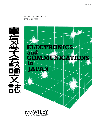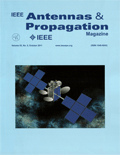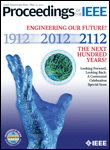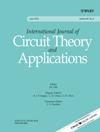
Journal of Electromagnetic Engineering and Science
Scope & Guideline
Driving Innovation Through Open Access Research
Introduction
Aims and Scopes
- Electromagnetic Theory and Applications:
The journal emphasizes research that advances the understanding of electromagnetic theory, including propagation, interaction, and applications in various domains such as telecommunications, radar, and biomedical fields. - Antenna Design and Optimization:
A significant focus is placed on innovative antenna designs, including compact, high-gain, and multifunctional antennas that meet the increasing demands of modern wireless communication systems. - Signal Processing Techniques:
The journal explores advanced signal processing methodologies, including machine learning and deep learning approaches, to enhance radar and communication systems' performance and efficiency. - Wireless Power Transfer Systems:
Research on wireless power transfer technologies is a core area, including the development of efficient power transfer mechanisms for various applications, such as electric vehicles and biomedical devices. - Microwave and Millimeter-Wave Engineering:
The journal publishes studies related to microwave and millimeter-wave technologies, including components design, system integration, and novel applications in communication and sensing. - Electromagnetic Compatibility and Interference:
Research addressing electromagnetic compatibility (EMC) and interference issues, particularly in complex environments, is recognized as a vital area of study. - Emerging Technologies in Electromagnetics:
The journal encourages submissions on cutting-edge technologies such as metasurfaces, terahertz systems, and flexible electronics, reflecting the evolving landscape of electromagnetic engineering.
Trending and Emerging
- Machine Learning and Artificial Intelligence in Electromagnetics:
There is a notable trend toward integrating machine learning and AI techniques into electromagnetic research, particularly for applications in radar signal processing and classification tasks. - Biomedical Applications of Electromagnetics:
Research that applies electromagnetic principles to biomedical engineering, such as wearable devices and medical imaging technologies, is on the rise, highlighting the importance of this interdisciplinary field. - 5G and Beyond Communication Technologies:
With the global rollout of 5G, there is a growing emphasis on research related to 5G technologies, including antenna design, signal processing, and network optimization. - Sustainable and Green Technologies:
Emerging studies are increasingly focusing on sustainable practices within electromagnetic engineering, such as energy-efficient designs and environmentally friendly materials for antennas and circuits. - Terahertz and Sub-Terahertz Technologies:
As research in terahertz technologies grows, there is a marked increase in publications exploring their applications in communication, sensing, and imaging, reflecting the potential of this frequency range. - Advanced Antenna Systems for IoT Applications:
The need for robust communication solutions in the Internet of Things (IoT) space is driving research into advanced antenna systems, focusing on compactness and multifunctionality.
Declining or Waning
- Traditional Electromagnetic Measurement Techniques:
Research focusing on conventional measurement methods for electromagnetic fields and devices has seen a decrease, possibly due to the rise of more advanced simulation and modeling techniques. - Basic Circuit Design for RF Applications:
There has been a waning interest in basic RF circuit design topics as the field evolves towards more integrated and sophisticated designs that address the complexity of modern systems. - Low-Complexity Algorithms for Basic Signal Processing:
While signal processing remains a key area, simpler algorithms and techniques are becoming less common as researchers seek more robust and complex solutions to meet contemporary challenges. - General Theoretical Studies without Practical Applications:
The journal appears to be moving away from purely theoretical studies that lack direct applicability, favoring research that demonstrates clear practical implications or advancements.
Similar Journals

MICROWAVE JOURNAL
Pioneering Research in Microwave SystemsMicrowave Journal, published by Horizon House Publications Inc, is a well-established platform in the field of Electrical and Electronic Engineering, specifically focusing on the advancements and applications of microwave technology. Since its inception in 1969, the journal has consistently delivered high-quality research, making it an invaluable resource for professionals, researchers, and students alike. Despite its Q4 ranking in Scopus for 2023, the journal plays a crucial role in disseminating knowledge and fostering innovation within its niche, showcasing developments across various areas including microwave systems, components, and applications. Although it does not offer Open Access, the journal’s comprehensive insights and peer-reviewed articles are essential for anyone looking to deepen their understanding of microwave engineering. By maintaining a rigorous editorial standard, Microwave Journal continues to shape the discussion and evolution of microwave technology.

Electronics and Communications in Japan
Connecting global minds through open-access research.Electronics and Communications in Japan, published by WILEY, serves as a vital platform for researchers and practitioners in the fields of applied mathematics, electrical and electronic engineering, and computer networks and communications. With a focus on advancing the understanding and development of communication technologies, this journal has been disseminating valuable research since its inception in 1975, including significant contributions from 2008 to 2024. While it currently holds a Q4 ranking in several categories including Physics and Astronomy, Applied Mathematics, and Signal Processing, it offers an essential outlet for emerging ideas and practices in these disciplines. As an open-access journal, it ensures that cutting-edge research is accessible to a global audience, supporting collaboration and innovation within the academic community. With an ISSN of 1942-9533 and an E-ISSN of 1942-9541, Electronics and Communications in Japan not only contributes to the scholarly discourse but also plays a critical role in shaping the future of technology and communication.

IEEE ANTENNAS AND PROPAGATION MAGAZINE
Connecting Researchers with Cutting-Edge Electromagnetic DiscoveriesIEEE Antennas and Propagation Magazine, published by the IEEE Institute of Electrical and Electronics Engineers Inc, is a prestigious journal renowned for its impactful contributions to the fields of Condensed Matter Physics and Electrical and Electronic Engineering. With an impressive 2023 impact factor, this journal holds significant rankings as part of the Q1 quartile in both fields, reflecting its rigorous peer-review process and the high quality of published research. Spanning from 1990 to 2024, it features a wide range of articles including theoretical research, comprehensive reviews, and practical applications in antenna design and propagation. Though it does not offer open access, the magazine remains a vital resource for researchers, professionals, and students seeking cutting-edge insights and advancements in electromagnetic theory and related technologies. Located in the United States, IEEE Antennas and Propagation Magazine is dedicated to fostering innovation and collaboration within the global scientific community, showcasing essential studies that advance the understanding of wave propagation and antenna technology.

Advanced Electromagnetics
Navigating the Evolving Landscape of ElectromagneticsAdvanced Electromagnetics, published by ADVANCED ELECTROMAGNETICS, GEEPS-SUPELEC, is an esteemed open access journal dedicated to the rapidly evolving fields of electrical and electronic engineering, as well as materials science, encompassing electronic, optical, and magnetic materials. With an ISSN of 2119-0275 and an established presence since 2012, the journal facilitates the dissemination of high-quality research and advancements, making substantial contributions to the scientific community. Operating from France, the journal proudly holds a Q3 quartile ranking in Electrical and Electronic Engineering for 2023, alongside rankings in Radiation and Electronic Materials. With a commitment to fostering innovation and interdisciplinary collaboration, Advanced Electromagnetics appeals to a broad audience of researchers, professionals, and students, encouraging them to share work that propels the field forward. Enjoy the seamless accessibility of research articles under an Open Access model, allowing for widespread dissemination and engagement with cutting-edge advancements in electromagnetics.

JOURNAL OF ELECTROMAGNETIC WAVES AND APPLICATIONS
Fostering Collaboration in Electromagnetic ResearchJournal of Electromagnetic Waves and Applications, published by Taylor & Francis Ltd, is a prestigious interdisciplinary journal that focuses on the rapidly evolving fields of electromagnetic waves and their applications. Since its inception in 1987, this journal has served as a vital resource for researchers, practitioners, and students interested in the latest advancements in electrical and electronic engineering, as well as materials science. The journal holds a respectable Q3 ranking in Electrical and Electronic Engineering and Electronic, Optical, and Magnetic Materials, and Q2 in Physics and Astronomy according to the 2023 category quartiles. With a dedicated readership, it aims to publish high-quality research articles that foster innovation and knowledge sharing among the scientific community. Despite not being open access, the journal ensures widespread availability of its insightful content aimed at pushing the boundaries of knowledge in the electromagnetic spectrum. As a crucial platform for disseminating cutting-edge research, the Journal of Electromagnetic Waves and Applications continues to contribute significantly to the advancement of technology and materials science.

IEEE Journal of Electromagnetics RF and Microwaves in Medicine and Biology
Unveiling the potential of RF technologies in biomedical fields.IEEE Journal of Electromagnetics RF and Microwaves in Medicine and Biology is a premier journal dedicated to advancing the frontiers of research in the interdisciplinary domains of electromagnetics and biomedical applications. Published by the renowned IEEE-INST ELECTRICAL ELECTRONICS ENGINEERS INC in the United States, this journal holds a distinguished reputation, exemplified by its Q1 rankings in the fields of Instrumentation and Radiation, as well as a solid Q2 ranking in Radiology, Nuclear Medicine, and Imaging for 2023. Covering a wide spectrum of topics—from RF and microwave technologies to their applications in medical diagnostics and treatment—the journal aims to foster collaboration among researchers, practitioners, and educators. With a commitment to high-quality peer-reviewed content and a strong impact factor reflecting its extensive reach in the field, the IEEE Journal of Electromagnetics RF and Microwaves in Medicine and Biology serves as an essential resource for professionals and scholars who seek to bridge the gap between engineering and medical sciences. Researchers looking to access cutting-edge findings can benefit from the journal's engagement with contemporary issues in health technology, enhancing both academic and practical knowledge in the evolving landscape of medical electromagnetics.

Progress in Electromagnetics Research Letters
Unveiling Insights in Electromagnetic TechnologiesProgress in Electromagnetics Research Letters, published by EMW PUBLISHING, is a vital peer-reviewed journal dedicated to the fields of electronics, optics, and magnetics. With an emphasis on innovative research and technological advancements, this journal has established itself in the academic community since its inception in 2008, and it will continue to publish valuable findings through 2024. The journal holds a respectable Q3 ranking in Electronic, Optical and Magnetic Materials, positioning it among the noteworthy contributions to the field, despite its percentile standing in Scopus. Researchers and professionals benefit from its commitment to disseminating high-quality research without the constraints of open access, ensuring that cutting-edge ideas reach a targeted audience. By fostering knowledge exchange, Progress in Electromagnetics Research Letters is poised to influence current and future advancements in electromagnetic technologies, making it a trusted platform for scholars and practitioners alike.

Advances in Radio Science
Accelerating Discoveries in Radio TechnologyAdvances in Radio Science, published by COPERNICUS GESELLSCHAFT MBH, is a leading open-access journal established in 2003, dedicated to the rapid dissemination of high-quality research in the field of radio science, particularly focusing on advancements in electrical and electronic engineering. With an ISSN of 1684-9965 and an E-ISSN of 1684-9973, this journal is indexed and provides an avenue for researchers to contribute to the latest developments and innovations within the domain. Despite its current Q4 ranking in the Electrical and Electronic Engineering category, its commitment to open access ensures that all published articles are freely available to a global audience, fostering collaboration and knowledge sharing among engineers, researchers, and students alike. Situated in Göttingen, Germany, the journal continues to evolve and expand its reach, with content converging until 2024, emphasizing its relevance in a rapidly changing technological landscape. Whether you're a seasoned researcher or an emerging scholar, Advances in Radio Science invites you to explore the frontiers of radio science and contribute to its growing body of knowledge.

PROCEEDINGS OF THE IEEE
Pioneering the Future of Electrical and Electronic EngineeringPROCEEDINGS OF THE IEEE, published by the IEEE-Institute of Electrical and Electronics Engineers Inc, stands as a premier journal within the fields of Computer Science and Electrical and Electronic Engineering. Since its inception in 1963, it has provided a platform for cutting-edge research and developments, showcasing innovative studies and breakthrough technologies that influence academia and industry alike. With an impressive Q1 ranking in both fields according to the latest quartiles, this journal ranks among the top in its categories, holding a prestigious spot in the Scopus metrics—ranking 1st in General Computer Science and 4th in Electrical and Electronic Engineering. Researchers, professionals, and students benefit from its comprehensive scope that includes a wide range of topics from algorithms and computing systems to circuit design and network technologies. Additionally, though not available as an open-access publication, its significant impact factor signifies its role in advancing scholarly dialogue and innovation in these fast-evolving fields. With contributions from leading experts and a commitment to high-quality research, the PROCEEDINGS OF THE IEEE continues to be an essential resource for anyone invested in technological progress and scientific inquiry.

INTERNATIONAL JOURNAL OF CIRCUIT THEORY AND APPLICATIONS
Cultivating Knowledge in Applied Mathematics and EngineeringINTERNATIONAL JOURNAL OF CIRCUIT THEORY AND APPLICATIONS serves as a premier platform for researchers and practitioners in the fields of applied mathematics, electrical and electronic engineering, and materials science. Published by Wiley, this esteemed journal, with an ISSN of 0098-9886 and an E-ISSN of 1097-007X, has been in circulation since 1973, providing insightful contributions and advanced research findings through 2024. It holds a commendable reputation across multiple disciplines, reflected in its 2023 ranking in the Q3 category across applied mathematics, computer science applications, and electronic materials. Researchers engaging with this journal can expect rigorous peer-reviewed articles that address both theoretical and practical implications, thereby fostering advancements in circuit theory and its multitude of applications. While the journal is not open access, it continues to play a significant role in disseminating high-caliber research crucial for scholars and professionals alike.